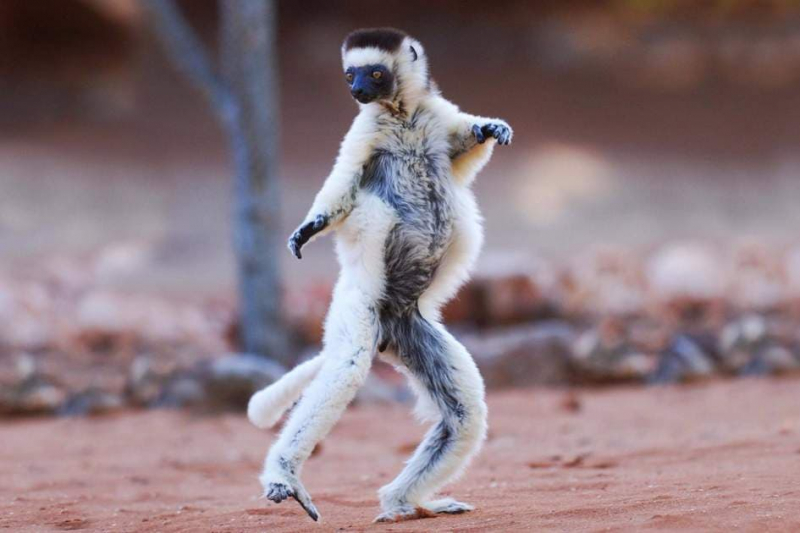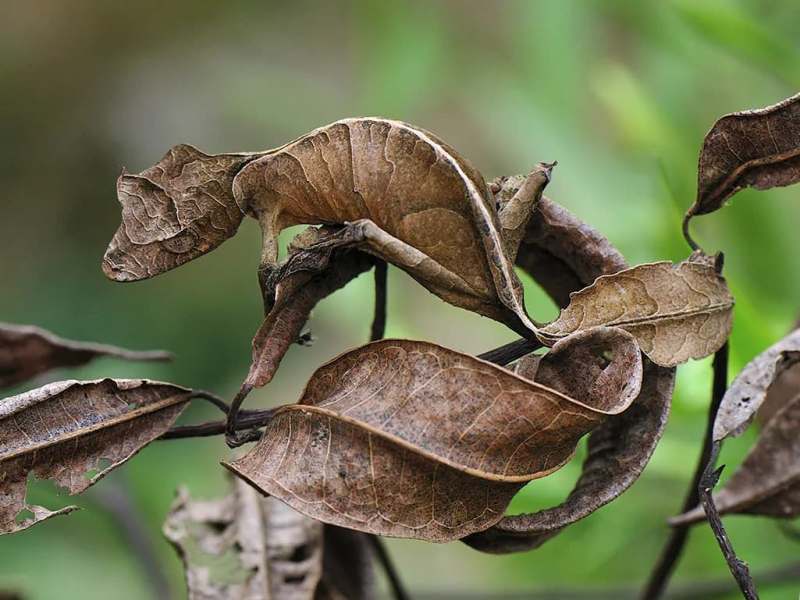Top 10 Fascinating Creatures Only Found In Madagascar
The majority of the fauna in Madagascar is endemic, meaning it cannot be found anywhere else on earth. The island's unique biodiversity is a result of its ... read more...geographic isolation. Madagascar is a hotspot for wildlife since it is one of the few pristine natural regions left in the world. It is home to almost 25,000 different wildlife species. Here is a list of fascinating creatures only found in Madagascar, let's find out!
-
The Madagascar Pochard is the rarest duck in the world, with a population of just 100. A medium-sized duck, the Madagascar Pochard matures to a length of 45–54 cm. They have an appealing white belly, reddish-brown flanks, and a greyish beak. They can only be found in Madagascar's marshes and freshwater lakes. For many years, it was believed that this exceptionally uncommon species of duck had gone extinct. However, at lake Mastsaborimena in 2006, about 20 Madagascar Pochards were rediscovered.
The Wildfowl and Wetlands Trust and the Durrell Wildlife Conservation Trust started a breeding program that same year. By 2013, the researchers had successfully increased Madagascar Pochard's population from 20 to 80. The loss of nesting grounds and the introduction of new species to their environment are to blame for the initial decline in the Pochard duck population. Due to the lack of food in their habitat, the Pochard ducks are still in danger of going extinct. The Pochard duck is a species of bird listed as severely endangered by the International Union for Conservation of Nature and Natural Resources (IUCN).

Via: eBird 
Via: eBird -
An unusual-looking bug native to Madagascar's woodlands is the giraffe weevil. Due to its extraordinarily long neck, the giraffe weevil earned its common name. The weevil neck of a male giraffe is two to three times longer than that of a female. Insect males use their long necks to construct nests and engage in competition with other males during mating season.
The giraffe weevil, is one of the largest insects in the weevil family, with an average length of 2.5 cm. Their body is primarily made up of black elements. In addition to their lengthy necks, giraffe weevils are most notable for their scarlet shells that cover their hind legs. It was known as an elytron. These shells aid in flight for giraffe weevils together with their hind wings.
At present, a large population of giraffe weevils lives in the forests of Madagascar. They spent most of their lives on small trees known as ‘giraffe beetle trees’. They also feed on the leaves of these trees. Luckily, there are no known predators to the giraffe weevils. Unlike their strange look, the giraffe weevil is completely harmless. They show no aggression towards humans or other species.

Via: 3 Minutes Nature 
Via: Beetle Identifications -
There are over 250 different bird species on the island of Madagascar. 44 percent of them, however, are unique to the planet. The blue coua is one such unusual bird found in Madagascar. It belongs to the family of cuckoo birds but is not parasitic. The Madagascar coucal is another name for the blue couas. They are well-known for having beautiful deep blue feathers.
The blue couas can range in length from 17 to 19.7 inches and weigh up to 235 g. Their entire body is almost entirely blue in hue. They have beautiful dark blue feathers and pale blue flesh around their eyes. Unfortunately, due to hunting, this stunning bird of Madagascar may become extinct soon.
The blue couas construct their own nests, unlike other cuckoo birds. To construct their nest, they use twigs and leaves. Blue coua nests typically remain undiscovered in bushes and trees. Throughout the breeding season, they only lay one egg. It's interesting to note that blue couas also tend to their own eggs.

Via: eBird 
Via: Infyworld -
The panther chameleon is one of the biggest chameleons in the world, measuring the same size as a house cat. They are 17 to 20 inches long. The island of Madagascar is home to this huge species of chameleon. The eye-catching technicolor skin of the panther chameleons is another reason for their fame.
The middle and northwest regions of Madagascar have coastal regions and islands where panther chameleons live. Depending on where they dwell, their skin has different color patterns. With various stripes and patches, the skin might be orange, red, blue, dark green, or blue-green in color. Panther chameleons are more vivid in the males than in the females.
Panther chameleons have the ability to quickly alter their color. This stunning color-changing is dependent on more than just the change in location. Additionally, their emotional state, physical condition, variations in temperature, and level of light all have an impact. When breeding or defending themselves, male panther chameleons exhibit this remarkable skin color change. Typically, female chameleons are a dull gray or brown tint. But they also turn pale to orange to pink in color during the breeding season.

Via: Chameleon Academy 
Via: Treehugger -
The term "tomato frog" refers to the species' striking orange-red skin. The only frogs with such bright, tomato-like coloring are females. The color of the male frogs is a duller brownish-orange. Tomato frogs are unquestionably among the world's most colorful creatures. They can only be discovered in Madagascar Island's jungles.
The tomato frogs are found in Madagascar in swamps, small pools, and other wetter areas of the island. Tomato frogs' vibrant coloring serves as a signal to would-be predators. However, tomato frogs aren't as dangerous, to ward off possible predators like snakes, their skin secretes a thick, sticky substance when threatened. The tomato frogs hunt in ambush. That indicates that they will wait in a specific location before surprising their prey. The majority of the tomato frogs' diet consists of insects and other tiny invertebrates.

Via: Everything Reptiles 
Via: Frogs -
The sifaka is a lovely kind of lemur that can only be found on the island of Madagascar. Sifakas can be divided into three primary categories: golden-crowned, cockerel's, and dialed. They are one of Madagascar's most critically endangered species. The primary hazard to sifakas is habitat loss.
Sifakas are medium-sized primates that can weigh up to 6 kg and have a body length between 16 and 22 inches. The sifakas' most distinctive characteristic is their long, silky fur. The fur comes in a variety of hues, including black, golden, white, and grey. These animals are creatures that live in trees. Most of their lives were spent on tree branches. With their strong rear legs, they can leap between the tree branches with ease. Sifakas are typically encountered in small groups of 6–10 people. Fruits, leaves, and buds are their main food sources.

Via: Insight Guides 
Via: Lemur Conservation Network -
The lemur, a primate that resembles a cat, is famous for living in Madagascar. In Madagascar's forests, there are 50 different species of lemur. The largest lemur found on the island of Madagascar is called Indri. They can weigh up to 10 kg and range in body length from 22 to 28 inches. With less than 10,000 individuals, indris are also one of the lemur species that are at risk of extinction.
The eastern half of Madagascar's rainforests are home to the indris. They stay together in tiny packs of four to eight creatures. Indris are known for calling out with a loud voice. They place these calls to talk to one another. These calls are audible from great distances. The indris spend the majority of their lives on trees, just like the sifakas do. Indris can easily grasp tree branches thanks to their muscular legs and large toes. This incredible lemur can jump up to 10 meters to cover a distance.

Via: Pinterest 
Via: iStock -
The largest carnivore, the fossa, can only be found in Madagascar's woodland. This creature can weigh up to 10 kg and grow to a length of 6 feet. The fossa initially reminds one of a hybrid between a cat and a mongoose. The main factor contributing to the decline in the fossa population in Madagascar is habitat destruction. They have a short reddish-brown coat and an extremely powerful, muscular body. One of the most distinctive characteristics of fossas is their lengthy tail. A fossa's tail really accounts for close to half of its overall length.
As climbers, the fossas are exceedingly quick. They can readily climb up on the trees because of their retractable claws and flexible ankle joints. They can move around the tree branches with the proper balance thanks to the long tail of fossas. The fossas move in a manner called "plantigrade" and walk on the soles of their feet, just like people do. The fossas may jump steadily from branch to branch thanks to it.
Among the animals that inhabit Madagascar, fossas are the most proficient hunter. It attacks its target unexpectedly because it is an ambush predator. Both day and night, the fossa hunt. With their razor-sharp teeth and claws, fossas may quickly dispatch their prey.

Via: Freepik 
Via: San Diego Zoo Animals & Plants -
There are only aye-ayes on the island of Madagascar. These unusual creatures might not appear to be primates at first glance, but they are linked to humans, chimpanzees, and other apes and apes. Aye-ayes dwell in trees in the rain forest and stay away from the ground. They spend the day curled up in a ball-shaped nest made of leaves and branches because they are nocturnal. The nests, which are found in the forks of huge trees, resemble closed spheres with a single access hole.
A bushy tail that is longer than their bodies distinguishes aye-ayes, which are dark brown or black in color. They also have large, sensitive ears, slender fingers, and wide eyes. With the exception of their opposable big toes, which allow them to dangle from branches, aye-ayes have pointy claws on all of their fingers and toes.
The aye-aye taps trees with its extended middle finger while sitting above the ground and listens for wood-boring bug larvae moving under the bark. The same middle finger is used to fish them out. The digit is also useful for scooping the flesh out of coconuts and other fruits that supplement the animal's insect diet.

Via: Wikipedia 
Via: Madagascar Wiki -
The satanic leaf-tailed gecko, a Madagascar endemic, is a master of concealment. This incredible lizard can blend in so well that it seems to be a dead leaf. The leaf-tailed gecko is difficult to see while it is perched above the leaf. This rare species from Madagascar blends in beautifully with its surroundings.
The satanic leaf-tailed gecko is only 10 to 15 cm long. The leaf-tailed gecko's incredible spectrum of colors includes grey, brown, tan, yellow, and orange. On their body, they also feature lines that resemble leaf veins, in order for the leaf-tailed gecko to accurately imitate a fallen leaf.
These animals sleep on tree branches or lie motionless over the dead leaves during the day. They have a distinct body shape and amazing color diversity, so they will quickly blend in with the surroundings. Thus, prospective predators like birds and snakes pose no threat to the satanic leaf-tailed geckos. The demonic leaf-tailed geckos employ a variety of defense mechanisms in addition to camouflage to stay safe. When approaching a predator, they expand their mouths widely to display their vividly red-colored mouth. In addition, they also have an upright tail. As a result, the demonic leaf-tailed geckos can fool the predator and get away from it.

Via: WIRED 
Via: WIRED































